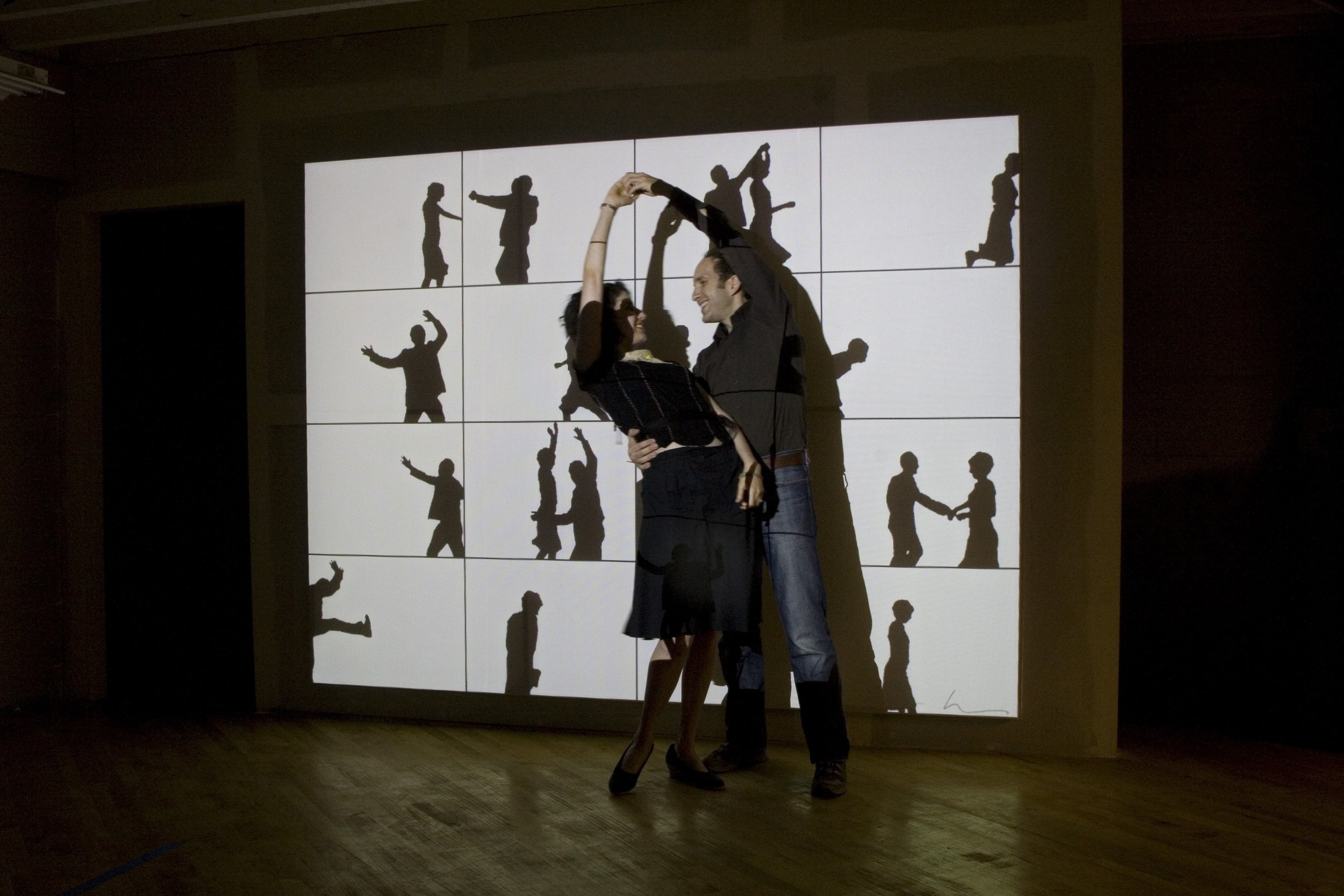Deep Walls (2002)
Deep Walls is a projected cabinet of cinematic memories. When a person walks into its projection beam, the interactive wall starts recording their shadow, and the shadows of those who follow. When the last person leaves the frame, the shadows replay within one of sixteen small rectangular cupboards, looping indefinitely. Like structural films, the collection of repetitive videos becomes an object unto itself, rather than strictly representational “movie.”
Deep Walls creates a complex temporal relationship between movie loops. Each small shadow film has the precise duration of its recording: from a few seconds to several hours. The temporal relationship between the sixteen frames is similar to Brian Eno’s tape loop experiments, looping individual recordings of different durations to create a composition that never repeats.
Deep Walls is inspired by the surrealist films of Jan Svankmajer and the Quay Brothers, and the sculpture of Joseph Cornell. In their films and sculptures, small bodies and obsessive collections of objects into cabinets and drawers represent psychological and spiritual states. The rational process of organization brings out unconscious irrationality.
Deep Walls’ name is inspired by a design pattern from architect Christopher Alexander’s Pattern Language. He recommends building the walls of homes thick, so that the inhabitants can carve out cabinets, drawers, and windows to personalize their homes. In the spirit of Alexander, the surface of Deep Walls grows to remember the contents of its environment.
EXHIBITION HISTORY
San Francisco Museum of Modern Art, 2003
Ars Electronica, Linz, Austria, 2003
Uijeongbu International Digital Art Festival. South Korea, 2003
Toki Messe. Nigata, Japan, 2003
Tarble Arts Center, Illiniois, 2004
Ars Numerica, Montbeliard, France, 2004
Art Rock, St. Brieuc, France, 2004
Art Interactive, Boston, Massachusetts, 2005
California Institute of the Arts, 2005
Global Economic Forum, San Jose, California, 2006
Israel Museum, 2006
Brown University (solo show), 2006
Milwaukee Art Museum, 2008
…
ABOUT THE SCREEN SERIES
Each work in the Screen Series starts with a pure rectangle of white light projected onto a wall. Through computer mediation, the projections react to viewers as soon as they step between screen and projector, putting their bodies and the projection on equal footing, or even making the body dominant to the projected image. In so doing, they allow viewers to create cinema with their bodies, either through reactive projections that respond to viewers, or through porous projections that record viewers' movements.
Though based in the contemporary technologies of computer vision, simulation, and digital projection, these works primarily refer back to the history of cinema and light projection, when silhouettes, rather than exact representations, graced animations, shadow theatre performances, and magic lantern productions. Like these precursors, the Screen Series emphasizes viewers’ shadows, rather than their photographic image. This emphasis on shadows paradoxically creates a stronger integration of viewers' bodies with the projections, since a picture of a viewer’s shadow is almost identical to the shadow itself, while a picture of a viewer’s body is less similar to their actual three-dimensional form. With such an approach, these works have a similar agenda as structuralist film: the removal of layers of cinematic illusion to reveal the nature of the image itself.
The Screen Series refers to the early years of cinema in a another way, remembering a time when cameras functioned as all-in-one photographic, developing, and projection devices. These early cameras first captured images onto film through a lens, then served as developing tanks when chemicals were poured into their bodies. Finally, the camera was emptied, dried, and turned into a projector by placing a light behind the lens. This contemporary combination of camera, projector, and computer echo those early cinema cameras, with computer “processing” replacing chemical processing.
Works in the Screen Series were produced with the support of The Beall Center for Art and Technology, Art Interactive, The San Francisco Media Arts Coalition, and GenArt San Francisco.
photographs by Kyle Knobel, Tavo Olmos and Scott Snibbe




